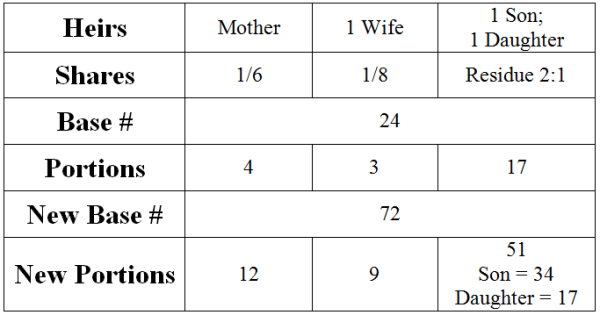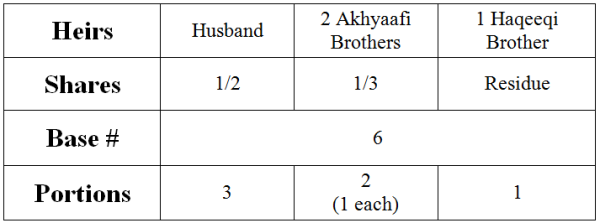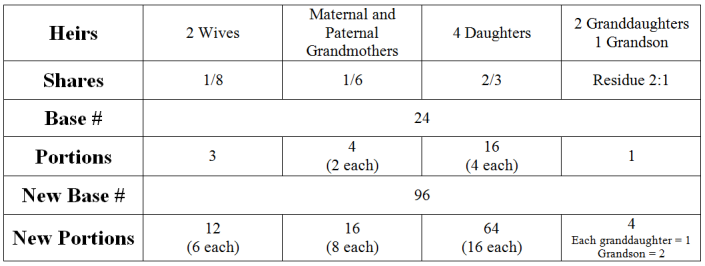Special Case: The Khuntha Mushkil (Indeterminate Hermaphrodite)
Below are the solutions (for both scenarios) to the problem given at the conclusion of the previous post:
Firstly, a hint was given. Here is answer to the hint: The baby of the step-mother is the mayyits allaati sibling.
Male (Allaati brother): The estate will be divided into 72 equal portions:
The Mother will get 12 portions.
Each Haqeeqi sister will get 16 portions.
The Allaati brother will get 6 portions.
Each Allaati sister will get 3 portions.
Everyone else is deprived.
Female (Twin Allaati sisters): The estate will be divided into 18 equal portions:
The Mother will get 3 portions.
Each Haqeeqi sister will get 4 portions.
The Allaati nephew will get 3 portions.
All others, including the allaati sisters, are deprived in this case.
Any questions/confusions concerning the above solution should be posted in the comments section, insha’Allah.
In Islamic fiqh (jurisprudence), the one who has both male and female reproductive organs is called a khuntha, or hermaphrodite. With regards to Islamic law, all measures will be taken to determine the gender of the hermaphrodite. Once the gender is determined, he/she will be treated as that gender for all shar`i ahkaam (legal rulings), including inheritance.
Certain signs need to be analyzed to determine the sex of the hermaphrodite, the first of which is the organ it uses to urinate. If it uses the male organ, he will be classified as a male; if it uses the female organ, she will be classified as a female. If the hermaphrodite urinates from both the male and female organs, then the first one to release urine will determine the gender. These signs should be analyzed at or immediately after birth to ascertain the sex of the hermaphrodite.
If these signs were not analyzed as a newborn, the sex can still be ascertained later, when more signs appear. These are outlined below.
The hermaphrodite will be classified as a male if any of the following occurs:
- He has sexual relations with his male reproductive organ.
- He experiences nocturnal discharge like men.
- He is inclined to women.
- He grows facial hair.
- His testimony of his inner self.
The hermaphrodite will be classified as a female if any of the following occurs:
- She has sexual relations with her female reproductive organ.
- She becomes pregnant.
- She experiences menstruation.
- She experiences the growth of breasts like women.
- She lactates.
All these signs should be looked out for when determining the gender of a hermaphrodite. If the hermaphrodite is classified as a male, he will inherit as a male in all cases. If the hermaphrodite is classified as a female, she will inherit as a female in all cases.
However, if none or all of these signs occur (which is extremely rare), then the hermaphrodite will not be assigned a gender. It will be termed a khuntha mushkil (indeterminate hermaphrodite).
Special laws will apply to a khuntha mushkil, but with regards to inheritance the khuntha mushkil will always inherit the lesser of the male or female share. In other words, the khuntha mushkil will be envisioned as a male and as a female in all inheritance scenarios. In whichever of the two cases it gets less inheritance, it will be treated as that gender and receive that share.
Lets work through some examples insha’Allah.
Example 1: A man dies leaving behind
- Mother
- 1 Wife
- 1 Daughter
- 1 Khuntha mushkil child
- 2 Granddaughters
- 1 Haqeeqi paternal uncle
Now we need to work out two different scenarios: one where the khuntha mushkil is a male and the other where its a female. In whichever scenario it gets less inheritance, that will be our final answer.
We will do this systematically, insha’Allah. For each scenario (male or female), first the rules of hujub hirmaan will be applied, then the chart will follow.
Male (Son): The granddaughters and haqeeqi paternal uncle are excluded. This leaves us with:
- Mother
- 1 Wife
- 1 Daughter
- 1 Son
Remember, the ‘son’ here is the khuntha mushkil.
Chart for Male (Son)
Female (Daughter): The granddaughters are excluded (due to the now two daughters). This leaves us with:
- Mother
- 1 Wife
- 2 Daughters
- 1 Haqeeqi paternal uncle
There are two daughters now, as one of them is actually the khuntha mushkil.
Chart for Female (Daughter)
Result:
The khuntha mushkil as a male (son) gets 34/72
The khuntha mushkil as a female (daughter) gets 8/24
A simple use of the calculator will tell us that 8/24 is less than 34/72, therefore the khuntha mushkil will get the share of the female (daughter) and thus the female chart will be used for the final answer.
Final Answer: The estate will be divided into 24 equal portions:
The Mother will get 4 portions.
The Wife will get 3 portions.
The Daughter will get 8 portions.
The Khuntha mushkil will get 8 portions.
The Haqeeqi paternal uncle will get 1 portion.
Take notice, in the final answer we’ve turned the second ‘daughter’ back into the khuntha mushkil. Remember, we are merely envisioning the khuntha mushkil as a male or female for the purpose of reaching the correct answer. The reality is that it is a khuntha mushkil and will be referred to as khuntha mushkil in the final answer.
Example 2: A woman dies leaving behind
- Husband
- 2 Akhyaafi brothers
- 1 Khuntha mushkil haqeeqi sibling
Male (Haqeeqi brother): No one is excluded.
Chart for Male (Haqeeqi brother)
Female (Haqeeqi sister): No one is excluded.
Chart for Female (Haqeeqi sister)
As you may have noticed, we had to apply `awl in the female scenario.
Result:
The khuntha mushkil as a male (haqeeqi brother) gets 1/6
The khuntha mushkil as a female (haqeeqi sister) gets 3/8
1/6 is less than 3/8, therefore the khuntha mushkil will get the share of the male (haqeeqi brother) and the male chart will be used for the final answer.
Final Answer: The estate will be divided into 6 equal portions:
The Husband gets 3 portions.
Each Akhyaafi brother gets 1 portion.
The Khuntha mushkil gets 1 portion.
Example 3: A man dies leaving behind
- 2 Wives
- Paternal grandmother
- Maternal grandmother
- 4 Daughters
- 2 Granddaughters
- 1 Khuntha mushkil grandchild
- 3 Akhyaafi brothers
- 1 Allaati sister
Male (Grandson): The akhyaafi brothers and allaati sister are all excluded. This leaves us with:
- 2 Wives
- Paternal grandmother
- Maternal grandmother
- 4 Daughters
- 2 Granddaughters
- 1 Grandson
Chart for Male (Grandson)
Female (Granddaughter): In this case, all the granddaughters and akhyaafi brothers are excluded by the daughters. This means that the khuntha mushkil will not inherit when envisioned as a female. Our list of heirs is:
- 2 Wives
- Paternal grandmother
- Maternal grandmother
- 4 Daughters
- 1 Allaati sister
Chart for Female (Granddaughter)
Result:
The khuntha mushkil as a male (grandson) gets 2/96
The khuntha mushkil as a female (granddaughter) gets nothing.
Of course, inheriting nothing is less than inheriting 2/96. Therefore, the khuntha mushkil will get the share of the female (granddaughter), i.e. no share, and the female chart will be used for the final answer.
Final Answer: The estate will be divided into 48 equal portions:
Each Wife gets 3 portions.
The Paternal grandmother gets 4 portions.
The Maternal grandmother gets 4 portions.
Each Daughter gets 8 portions.
The Allaati sister gets 2 portions.
The khuntha mushkil as well as the granddaughters and akhyaafi brothers will not inherit.
Lets end this post with an example problem you can try on your own, insha’Allah.
A woman dies leaving behind:
- Husband
- Mother
- Father
- 1 Khuntha mushkil child
How will the estate be divided and distributed?







December 27, 2015 at 4:07 PM
Example 3 doesn’t make sense. The final answer for example 3 isn’t correct and doesn’t follow from the charts.
December 28, 2015 at 3:59 AM
JazaakAllahu khayran for pointing that out brother. It seems the wrong charts were posted for this example. The charts have been updated now to the correct ones. Please let us know of any other errors you find.
Much appreciated.
December 27, 2015 at 4:09 PM
Shouldn’t the khuntha mushkil be getting nothing in both cases?
December 28, 2015 at 4:02 AM
Which example are you talking about here? If its example 3, then please know that the charts have been updated. Take a look at them and see if the results for male and female make more sense now insha’Allah.
If its another example you are talking about, let me know please.
JazaakAllah.
December 29, 2015 at 2:20 AM
Thank you brother. It makes sense now. It was the charts that were confusing.